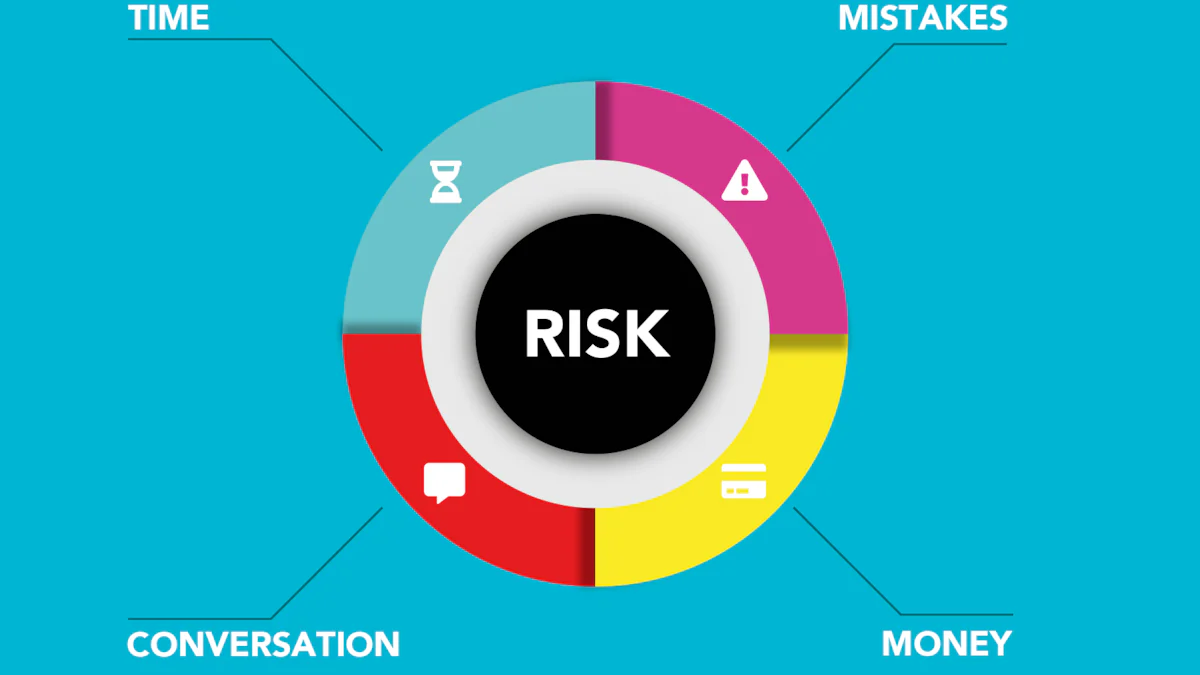Clearing the Path: A Guide to Effective Supply Chain Risk Management

Supply chain risk management is essential for companies to navigate the challenges posed by disruptions. The recent survey conducted by SIS International Research revealed that 84% of businesses have encountered component shortages, while 75% faced delays in time-to-market. Moreover, geopolitical factors have complicated supply chain processes for 67% of companies. The COVID-19 pandemic further exacerbated these issues, with 38.8% of US small businesses reporting delays. Understanding and effectively managing these risks are crucial for sustained success.
Understanding Supply Chain Risks

In the realm of supply chain management, risks lurk at every corner, ready to disrupt operations and hinder progress. These risks come in various forms, each with its own set of challenges that can impact the seamless flow of goods and services. By understanding these risks and proactively addressing them, companies can fortify their supply chains against potential disruptions.
Types of Supply Chain Risks
Operational Risks
Operational risk management is paramount in ensuring the smooth functioning of day-to-day activities within a supply chain. From machinery breakdowns to labor strikes, operational risks can arise unexpectedly, causing delays and bottlenecks in production processes. By implementing robust operational procedures and contingency plans, companies can mitigate these risks effectively.
Financial Risks
Financial risk management plays a crucial role in safeguarding the economic stability of a supply chain. Fluctuations in currency exchange rates, payment defaults by partners, or unexpected price hikes can all pose financial threats to businesses. By conducting thorough financial analyses and establishing risk mitigation strategies, companies can protect their bottom line from potential losses.
Strategic Risks
Strategic risk management involves anticipating and addressing long-term challenges that may impact the overall direction of a supply chain. Changes in market trends, shifts in consumer preferences, or disruptions caused by competitors can all pose strategic risks to businesses. By staying agile and adaptable, companies can navigate these uncertainties and maintain a competitive edge in the market.
Identifying and Analyzing Risks
Risk Identification Techniques
Effective risk management begins with identifying potential threats before they escalate into full-blown crises. Utilizing techniques such as scenario planning, historical data analysis, and stakeholder consultations can help businesses uncover hidden risks within their supply chains. By staying vigilant and proactive in risk identification, companies can stay one step ahead of potential disruptions.
Risk Analysis Methods
Once risks are identified, it is essential to analyze their potential impact on the supply chain thoroughly. Quantitative methods like risk mapping, probabilistic modeling, and sensitivity analysis can provide valuable insights into the likelihood and severity of various risks. By leveraging advanced analytical tools and methodologies, companies can make informed decisions on how best to address identified risks.
Implementing Risk Management Strategies

Developing a Risk Management Plan
To ensure the resilience of the supply chain, companies must prioritize the development of a comprehensive risk management plan. This plan serves as a roadmap for navigating potential disruptions and safeguarding operations against unforeseen challenges. By setting clear objectives and conducting thorough risk assessments, businesses can proactively identify vulnerabilities within their supply chains.
Setting Objectives
Establishing clear objectives is the cornerstone of an effective risk management plan. Companies should define specific goals that align with their overall business strategy and risk tolerance levels. By outlining measurable targets and timelines for risk mitigation efforts, organizations can track progress and adapt strategies as needed to enhance supply chain robustness.
Risk Assessment
Conducting rigorous risk assessments is essential for understanding the potential threats facing the supply chain. Through in-depth analysis of internal processes, external dependencies, and market dynamics, companies can pinpoint areas of vulnerability and prioritize mitigation efforts. By leveraging data-driven insights and scenario planning techniques, businesses can anticipate risks before they materialize and implement targeted solutions.
Risk Mitigation Techniques
Incorporating effective risk mitigation techniques is crucial for minimizing the impact of disruptions on supply chain operations. Diversification strategies, such as sourcing from multiple suppliers or expanding distribution channels, can help reduce dependency on single sources and enhance flexibility. Additionally, contingency planning enables companies to prepare alternative courses of action in response to unforeseen events, ensuring continuity in critical business functions.
Diversification
Diversifying suppliers, transportation routes, and production locations can mitigate risks associated with localized disruptions or supplier failures. By spreading resources across multiple channels, companies can enhance resilience and adaptability in the face of changing market conditions or unexpected events. Embracing a diversified approach to supply chain management strengthens business continuity efforts and minimizes vulnerabilities.
Contingency Planning
Developing robust contingency plans is essential for responding swiftly to unexpected disruptions in the supply chain. By outlining predefined response protocols, resource allocation strategies, and communication mechanisms, organizations can streamline crisis management efforts and minimize downtime. Effective contingency planning ensures that businesses are prepared to address emergencies proactively and maintain operational stability during challenging times.
Monitoring and Reporting
Continuous monitoring and reporting are fundamental components of effective supply chain risk management practices. Daily monitoring allows organizations to stay vigilant against emerging threats and proactively address issues before they escalate into major crises. Establishing robust reporting mechanisms enables timely communication of risks across all levels of the organization, fostering transparency and accountability in risk management processes.
Daily Monitoring
Implementing real-time monitoring tools and dashboards empowers businesses to track key performance indicators (KPIs) related to supply chain risks continuously. By analyzing data trends, identifying anomalies, and generating alerts for potential disruptions, companies can take proactive measures to mitigate risks promptly. Daily monitoring enhances situational awareness and enables agile decision-making in response to evolving threats.
Reporting Mechanisms
Establishing clear reporting mechanisms ensures that relevant stakeholders are informed about potential risks affecting the supply chain. Regular reports detailing risk exposure levels, mitigation activities, and incident responses facilitate informed decision-making at all organizational levels. Transparent communication channels enable swift coordination during crises and promote a culture of accountability in managing supply chain risks effectively.
Building a Risk Management Culture
Promoting Risk Awareness
Training Programs
Educating teams about potential threats and opportunities is a cornerstone of effective risk management. By fostering a culture of continuous learning and development, organizations can empower employees to proactively identify and address risks within the supply chain. Training programs play a vital role in enhancing risk awareness across all levels of the company, equipping staff with the knowledge and skills needed to mitigate potential disruptions effectively.
Conduct regular training sessions on risk identification techniques and mitigation strategies.
Encourage cross-functional collaboration to share insights and best practices for managing risks.
Provide resources and tools to support ongoing learning and skill development in risk management.
Communication Strategies
Effective communication is essential for promoting risk awareness and ensuring alignment on risk management objectives. Clear and transparent communication channels enable stakeholders to stay informed about potential threats, mitigation efforts, and incident responses. By fostering open dialogue and sharing relevant information proactively, organizations can enhance collaboration, decision-making, and overall resilience in the face of supply chain risks.
"Effective risk management requires getting teams interested in educating themselves about potential threats." - Heywoord
Integrating Risk Management into Business Strategy
Aligning with Business Goals
Integrating risk management into the broader business strategy is critical for aligning risk mitigation efforts with organizational objectives. By embedding risk considerations into strategic planning processes, companies can ensure that risk management activities support and enhance overall business goals. This alignment enables proactive decision-making, resource allocation, and prioritization of initiatives that strengthen the resilience of the supply chain.
Incorporate risk assessments into strategic planning discussions at all levels of the organization.
Define key performance indicators (KPIs) related to risk management to track progress towards business objectives.
Regularly review and adjust risk management strategies to align with evolving business priorities.
Continuous Improvement
Continuous improvement is key to building a dynamic and adaptive approach to supply chain risk management. By fostering a culture of innovation, learning, and feedback, organizations can identify areas for enhancement, refine existing processes, and implement best practices for mitigating risks effectively. Embracing a mindset of continuous improvement enables companies to stay ahead of emerging threats, seize opportunities for growth, and drive sustainable success in an ever-changing business landscape.
"Risk Management interviews are designed to probe your ability to anticipate risks." - Interview Questions for Risk Management
Effective risk management is paramount in the ever-evolving landscape of supply chain operations. Reflecting on past disruptions, industry experts prioritize strategies such as risk quantification, scenario planning, and data sharing to enhance control measures. Recent challenges have reshaped the assessment of risks and decision-making processes, emphasizing the critical role of risk mitigation in supply chain management. Organizations must weigh the costs of building resilience against potential risks to ensure sustainable operations and long-term success.
See Also
Preparedness in Action: JUSDA's Resilient Supply Chain Management
Seamless Success: Ensuring Supply Chain Continuity
Transforming Transportation: Supply Chain Innovation's Influence
Optimizing Operations: Addressing High-Tech Manufacturing's Supply Chain Challenges
